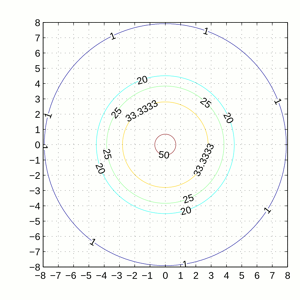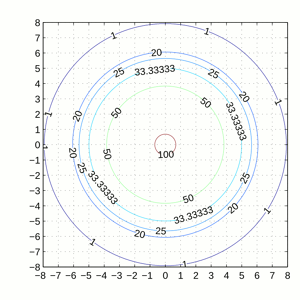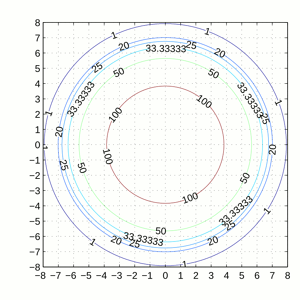An explosion is a physical event in the Minecraft world, caused by a primed TNT, a creeper, or a fireball launched by Ghasts. An explosion can destroy nearby blocks, propel and damage nearby entities, and start fire.
Properties
- Position. A TNT explosion happens at the center of a primed TNT, which is a 0.98 × 0.98 × 0.98 cube.
- Power. Power of an explosion determines its blast radius. TNT explosion has 4 power, creeper explosion has 3 (6 when charged by lightning), fireball explosion has 1.
- Ability to generate fire. Currently only fireball explosion can start fire.
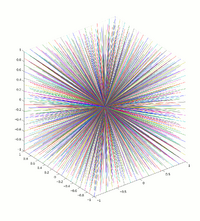
Explosion rays
Process
Destroying blocks
- Start linearly in the direction from the explosion point to each of 1352 points that uniformly distributed on the surface of a cube centered at the explosion with an edge length of 2.
- Let blast force on each line equal the explosion power multiplied by a random number in [0.7, 1.3].
- Check current block every step of 0.3. A non-air block absorbs (blockResistance / 5 + 0.3) · step of the blast force; if the blast force is not completely absorbed, the block is destroyed (air blocks can also be marked as destroyed).
- The blast force is attenuated by step · 0.75 each step, if the blast force is completely absorbed or attenuated, perform the same process on the next line.
The maximum travel distance in the air of a TNT explosion is 6.9, 5.1 for a creeper explosion, and 1.5 for a fireball explosion. For example, a TNT explosion can destroy a torch 7 blocks away. The minimum block resistance required to absorb maximum blast force of TNT explosion (within a distance of 2 steps) is 77.67, 63.5 of creeper explosion, 20.17 of fireball explosion. Water, stationary lava, and obsidian can be destroyed with sufficient tnt (For obsidian, 77 units of TNT must be within one block of the obsidian). However bedrock is always indestructible, requiring over 231,000 TNT. No computer system a homeowner would have is capable of doing this without crashing and ruining the save file. Note also that these would need to be within 1 unit of the block in question, as well as would need to explode simultaneously.
Destroyed blocks have 30% chance of being dropped as items. All standing items caught in the explosion are destroyed. The 30% chance of being dropped applies to a chest as well, but its contents are exempt from this check and will not be destroyed regardless of whether or not the chest block was dropped.
Interaction with entities
Define attenuation as the ratio of distance from explosion to the blast radius that equals 2 · power.
- For each entity where attenuation is less than 1, let impact equal (1 - attenuation) · exposure.
- Try to apply (impact · impact + impact) · 4 · radius + 1 damage to the entity, and propel the entity so that its velocity increases by impact in the direction from explosion to the entity.
As a result, entities will always get at least 1 damage if they are within blast radius, regardless of explosion exposure.
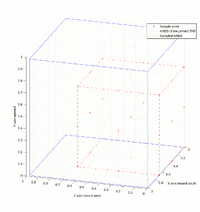
Primed TNT AABB
Calculation of explosion exposure
Explosion exposure is the ratio of visible sample points to all sample points drawn uniformly from the axis-aligned bounding box (AABB) of the affected entity. Point visibility is determined with ray tracing from the explosion point to sample points. Details on the sampling method and ray tracing are beyond the scope of this article. The spacing of sample points of a primed TNT is 1/2.96.
AABB sampling error results in directional asymmetry of propulsion. For example, a typical TNT cannon has maximum range in the west direction partly because the sampled AABB of a primed TNT has largest exposure in that direction.
Causing fire
If the explosion has the ability, it will randomly start fire in 1/3 of all destroyed air blocks that are above opaque blocks. Prior to Beta 1.3, Ghasts' fireballs could start fire.
Blast Resistance
The data below is pulled from a running instance of Minecraft (Beta 1.3) and kept in a template. [edit]
| Block Name | Blast Resistance |
|---|---|
| Bedrock | Template:Blast Resistance Values |
| Obsidian | Template:Blast Resistance Values |
| Lava | Template:Blast Resistance Values |
| Water | Template:Blast Resistance Values |
| Brick (Block) | Template:Blast Resistance Values |
| Cobblestone | Template:Blast Resistance Values |
| Diamond (Block) | Template:Blast Resistance Values |
| Gold (Block) | Template:Blast Resistance Values |
| Iron (Block) | Template:Blast Resistance Values |
| Jukebox | Template:Blast Resistance Values |
| Moss Stone | Template:Blast Resistance Values |
| Stone Stairs | Template:Blast Resistance Values |
| Slabs | Template:Blast Resistance Values |
| Stone | Template:Blast Resistance Values |
| Iron Door | Template:Blast Resistance Values |
| Monster Spawner | Template:Blast Resistance Values |
| Dispenser | Template:Blast Resistance Values |
| Furnace | Template:Blast Resistance Values |
| Coal (Ore) | Template:Blast Resistance Values |
| Diamond (Ore) | Template:Blast Resistance Values |
| Wooden Door | Template:Blast Resistance Values |
| Fence | Template:Blast Resistance Values |
| Gold (Ore) | Template:Blast Resistance Values |
| Iron (Ore) | Template:Blast Resistance Values |
| Lapis Lazuli (Block) | Template:Blast Resistance Values |
| Block Name | Blast Resistance |
|---|---|
| Lapis Lazuli (Ore) | Template:Blast Resistance Values |
| Redstone (Ore) | Template:Blast Resistance Values |
| Wooden Stairs | Template:Blast Resistance Values |
| Wooden Plank | Template:Blast Resistance Values |
| Chest | Template:Blast Resistance Values |
| Crafting Table | Template:Blast Resistance Values |
| Wood | Template:Blast Resistance Values |
| Bookshelf | Template:Blast Resistance Values |
| Jack-O-Lantern | Template:Blast Resistance Values |
| Pumpkin | Template:Blast Resistance Values |
| Sign | Template:Blast Resistance Values |
| Note Block | Template:Blast Resistance Values |
| Sandstone | Template:Blast Resistance Values |
| Wool | Template:Blast Resistance Values |
| Rails | Template:Blast Resistance Values |
| Clay (Block) | Template:Blast Resistance Values |
| Farming | Template:Blast Resistance Values |
| Grass | Template:Blast Resistance Values |
| Gravel | Template:Blast Resistance Values |
| Cake | Template:Blast Resistance Values |
| Dirt | Template:Blast Resistance Values |
| Ice | Template:Blast Resistance Values |
| Lever | Template:Blast Resistance Values |
| Pressure Plates | Template:Blast Resistance Values |
| Block Name | Blast Resistance |
|---|---|
| Sand | Template:Blast Resistance Values |
| Soul Sand | Template:Blast Resistance Values |
| Stone Button | Template:Blast Resistance Values |
| Cactus | Template:Blast Resistance Values |
| Ladders | Template:Blast Resistance Values |
| Netherrack | Template:Blast Resistance Values |
| Glass | Template:Blast Resistance Values |
| Glowstone (Block) | Template:Blast Resistance Values |
| Bed | Template:Blast Resistance Values |
| Leaves | Template:Blast Resistance Values |
| Snow (Block) | Template:Blast Resistance Values |
| Snow | Template:Blast Resistance Values |
| Seeds (Item) | Template:Blast Resistance Values |
| Flowers | Template:Blast Resistance Values |
| Fire | Template:Blast Resistance Values |
| Mushrooms | Template:Blast Resistance Values |
| Portal | Template:Blast Resistance Values |
| Redstone (Wire) | Template:Blast Resistance Values |
| Redstone (Torch) | Template:Blast Resistance Values |
| Redstone (Repeater) | Template:Blast Resistance Values |
| Sugar Cane | Template:Blast Resistance Values |
| Sapling | Template:Blast Resistance Values |
| TNT | Template:Blast Resistance Values |
| Torch | Template:Blast Resistance Values |
| Air | Template:Blast Resistance Values |
Typical blast radii
- Player kill radii of 1, 2, 4 TNT explosion on the ground with 100% exposure: lowest damage isoline; 0%, 25%, 50%, 75%, 100% armor one hit kill isolines.

